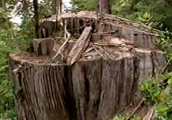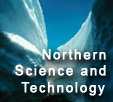Tree DNA (deoxyribonucleic acid)

Streaming Video - High resolution | Low resolution | RealPlayer Help
Summary
DNA analysis may soon be used to trap tree thieves. In British Columbia, up to $20 million is lost annually when timber is taken illegally from Crown land, private land and ecological reserves. Catching these unauthorized loggers red-handed as they harvest old-growth timber would be ideal, but not very likely, considering the millions of hectares of forested land in the province. Until now, the only way to match a stolen log with its stump -- and secure a conviction -- was to compare the shape and number of tree rings on both. The work of a Natural Resources Canada scientist to harness tree DNA will make this matching easier and cheaper.
Transcript of Video
Narrator
What do the OJ Simpson trial and a Canadian scientific advance have to do with the case of the stolen 800 year old red cedar?
Dr. Eleanor White
This is the tree. One day I got a phone call from somebody in the BC Forest Service who was spitting mad. He'd been up to check on some fallers who were working near here, came into this park, and saw that this big tree had been cut. He said in a lot of cases we have a pretty fair idea of who's doing it, but unless you can catch them in the act, you can't get a conviction. The OJ Simpson trial was on at the time and he said what we need is DNA evidence like they're using for OJ Simpson, so that we can match up the wood in the back of the truck to the illegally harvested stump. So after I finished laughing I thought... I wonder if you could do it?
Narrator
Matching the DNA of a stump with the suspected stolen wood had never been done before. In 1996 Dr. White began studying tree DNA.
Dr. Eleanor White
It's hard to believe, but each tree has unique DNA. Tree DNA is surprisingly similar to human DNA. It has the same basic building blocks. It has the same bases. They're arranged in the same way. The genetic code is the same in trees and in humans. There's a surprising similarity.
Narrator
Because trees have unique DNA, it makes accurate matching possible. Dr. White's challenge has been to find the sections of DNA that are optimal for tree ID.
Dr. Eleanor White
Once we've extracted and purified the DNA, then we amplify particular regions of the DNA that are useful for doing identification. These regions are called microsatellites. They're just sections of DNA that happen to be very different between different individuals.
Narrator
A single matching microsatellite, or marker, can be either a true match, or chance. The more DNA markers that are compared, the lower the probability of a random match.
Dr. White has studied the DNA of over a hundred trees, searching for the most useful markers. Of the half dozen or so promising markers, three are suitable and a fourth is being studied. With four DNA markers to compare, the probability of a random match is as low as one or two in a million. With odds like that, DNA matching can be used as evidence against tree rustlers.
Jerry Hunter
It's going to assist us two ways. Number one - the DNA technology will assist us in securing convictions in court. The other thing that it will do is speed up our investigation process and make it significantly easier. Rather than having to pick up a whole bunch of these shake blocks which can weigh 80-100 pounds each, 40 kilograms or more, we don't have to carry a whole bunch of those down the hill. Instead all we have to do is get a bunch of the sawdust or get a bunch of small pieces of samples which the forensic lab can then analyze.
Narrator
In the case of the stolen 800 year old red cedar, the thief wasn't convicted because the allegedly stolen wood couldn't be matched to this stump. But in the future, Dr. White's continuing DNA work will give enforcement agencies the proof they need to tie the evidence to the crime scene. The day when tree DNA is used as evidence in court, it'll be a legal and scientific first in Canada ... maybe even the world.
Earth Tones is produced in co-operation with Natural Resources Canada.






